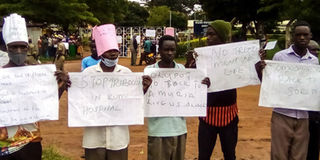Ongino hospital staff protest salary delays

Junior staff at Ongino Hospital in Kumi District carry placards during a strike on Monday. PHOTO | VICENT EMONG
What you need to know:
- Mr William George Omoding, the hospital administrator, said Ongino is a donor-funded health facility which faces a shortage of funds but co-shares the cost with patients, and gets additional support from the government in form of drugs. The hospital was built in the early 1920s by the White Missionaries to handle cases of leprosy, among other diseases.
BY VICENT EMONG
Junior staff at Ongino Hospital in Kumi District have gone on strike over delayed salary payment.
The staff, who were joined by their families, blocked the entry to the hospital on Monday in protest, claiming that they have not been paid for six months.
They also cite denial of their right to free medication at the health facility.
Ms Florence Adongo, one of the affected staff, said despite their pleas to management, it has not communicated to them about when their grievances will be addressed.
Sexual harassment
Ms Adongo also cited sexual harassment as one of the reasons for the strike.
“Also terms of recruitment should be revisited,” she said, adding that 28 junior staff have lost jobs and have been denied access to treatment.
Ms Margaret Asire, a cleaner, told Daily Monitor that she is demanding the hospital Shs260,000 in arrears.
However, Mr Charles Okunya Oode, the chairperson of the hospital board of management, called for calm, promising that the board of governors would find a suitable way forward. He said developments were being undertaken to improve services at the health facility.
Mr William George Omoding, the hospital administrator, said the staff who have not been paid will receive their salaries.
State of hospital
Mr William George Omoding, the hospital administrator, said Ongino is a donor-funded health facility which faces a shortage of funds but co-shares the cost with patients, and gets additional support from the government in form of drugs. The hospital was built in the early 1920s by the White Missionaries to handle cases of leprosy, among other diseases.




